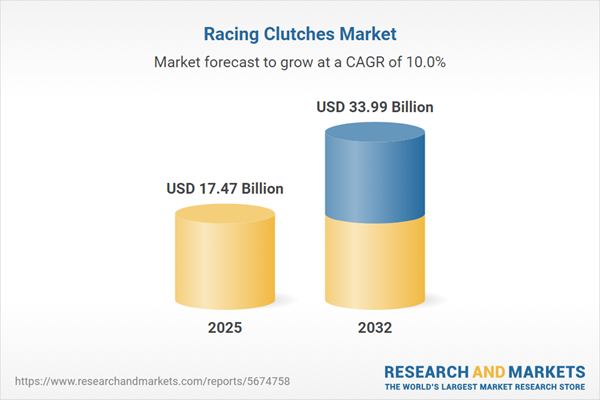Speak directly to the analyst to clarify any post sales queries you may have.
The global racing clutches market is in the midst of dynamic evolution as industry leaders adapt to ongoing regulatory changes, new technology trends, and the imperative for optimized capital allocation and supply chains. Adaptability is essential for maintaining a competitive edge in this complex sector.
Market Snapshot: Racing Clutches Market Growth and Trends
The racing clutches market is projected for strong expansion through 2032, fueled by consistent demand for advanced clutch systems across motorsport applications. High-performance needs within the racing industry have spurred major investment from both automotive OEMs and motorsport authorities, concentrating on solutions that address advancing regulations and technical standards. Manufacturers are placing greater emphasis on enhancing reliability, supporting efficient vehicle operation, and optimizing cost-effectiveness over the product lifecycle. Advanced clutch technologies are increasingly central to ensuring responsive vehicle performance and operational durability, positioning the market to capitalize on emerging motorsport trends and engineering priorities.
Scope & Segmentation: Racing Clutches Market Structure
- Clutch Types: Single plate clutches are crafted for fast driver engagement, while multi plate concepts focus on delivering superior torque management, meeting the range of requirements seen in diverse motorsport disciplines.
- Material Types: Ceramic systems enhance endurance racing capabilities, metal matrix composites prioritize toughness for high-load scenarios, and organic clutch variants are favored where smooth operation and noise optimization are critical.
- Vehicle Types: Clutch solutions are developed for a mix of commercial vehicles, multi-terrain motorcycles, and specialized passenger cars, each presenting design challenges to meet targeted race conditions and driver expectations.
- End User Industries: The aftermarket features rapid adoption of retrofit technologies to align with shifting preferences, while OEM customers are drawn to integrated systems that offer extended warranties and technical support.
- Actuation Types: Electronic, hydraulic, and manual systems are deployed according to vehicle layout, enabling tailored solutions and supporting a diversity of racing formats and technical requirements.
- Regional Coverage: The Americas benefit from advanced compliance frameworks and robust sourcing practices, EMEA stands out for regulatory rigor and established manufacturing expertise, and Asia-Pacific demonstrates high-paced research activity with sharp regional competition spurring ongoing innovation.
- Leading Companies: Industry participants such as AP Racing Ltd., Tilton Engineering, SPEC Clutch, Exedy Corporation, McLeod Racing, Advanced Clutch Technology, Centerforce Clutch, Clutch Masters, Circle D Manufacturing, and Ogura Industrial Corporation continue to expand offerings and increase technological investment to meet intricate motorsport and aftermarket demands.
Key Takeaways: Strategic Guidance for Senior Decision-Makers
- Advanced ceramic and composite materials significantly extend life cycles, supporting clutch operation under extreme stress and prolonged racing events.
- Widespread implementation of digital diagnostics and onboard sensor capabilities delivers real-time maintenance visibility while supporting system optimization and reduced unscheduled downtime.
- Continual product innovation enhances seamless integration with hybrid and electric drivetrains, creating options that address the next generation of mobility technologies.
- Focusing procurement strategies on automation and localized sourcing increases responsiveness to potential supply chain shifts, optimizing reliability and fostering more agile production ecosystems.
- Pursuing sustainable sourcing initiatives not only supports evolving global compliance obligations but also enhances partnership appeal among international stakeholders.
- Operational agility remains a core strength, as OEMs and suppliers must quickly detect market shifts and adapt products to dynamic aftermarket requirements.
Tariff Impact: Market Adjustments in Racing Clutches
Recent US tariff policy revisions have pressed manufacturers to reexamine supply chain models, intensifying focus on domestic supplier partnerships and greater automation investment. These actions reflect a commitment to operational continuity and greater regulatory compliance, helping companies prepare for policy-driven market variability. Enhanced resilience allows organizations to navigate disruptive changes and maintain stable support for end-users.
Methodology & Data Sources
This analysis leverages technical reviews, insights from drivetrain engineering experts, targeted supplier interviews, and regulatory monitoring. Scenario modeling further supports recommendations, ensuring each strategic option is informed by proven industry scenarios and reliable data sources.
Why This Report Matters
- Enables senior decision-makers to steer their organizations successfully through regulatory and technological transformation by providing current, actionable insights for supply chain and procurement.
- Guides the integration of digital diagnostic and sustainable practices into production workflows, supporting sustained compliance and operational value.
- Offers a comprehensive perspective for executives making investment decisions or adapting to fluctuating customer and engineering requirements.
Conclusion
This report supports executives in defining robust, forward-looking strategies for the racing clutches market. Successful adaptation to evolving industry factors remains essential to sustaining leadership and competitive capability.
Additional Product Information:
- Purchase of this report includes 1 year online access with quarterly updates.
- This report can be updated on request. Please contact our Customer Experience team using the Ask a Question widget on our website.
Table of Contents
3. Executive Summary
4. Market Overview
7. Cumulative Impact of Artificial Intelligence 2025
Companies Mentioned
The companies profiled in this Racing Clutches market report include:- AP Racing Ltd.
- Tilton Engineering, Inc.
- SPEC Clutch, Inc.
- Exedy Corporation
- McLeod Racing, Inc.
- Advanced Clutch Technology, Inc.
- Centerforce Clutch, Inc.
- Clutch Masters, Inc.
- Circle D Manufacturing, LLC
- Ogura Industrial Corporation
Table Information
| Report Attribute | Details |
|---|---|
| No. of Pages | 195 |
| Published | November 2025 |
| Forecast Period | 2025 - 2032 |
| Estimated Market Value ( USD | $ 17.47 Billion |
| Forecasted Market Value ( USD | $ 33.99 Billion |
| Compound Annual Growth Rate | 10.0% |
| Regions Covered | Global |
| No. of Companies Mentioned | 11 |









